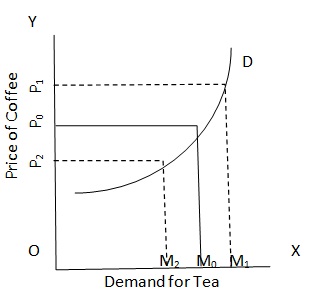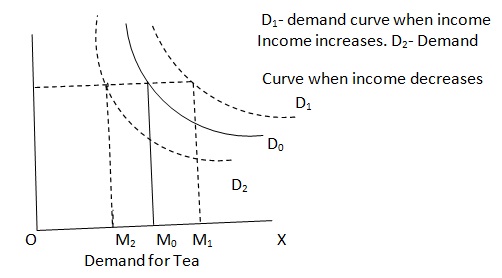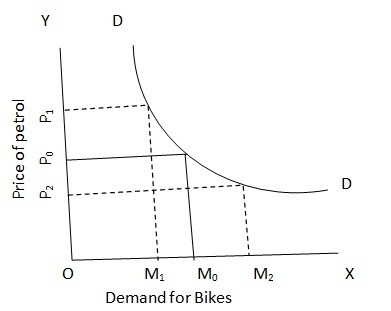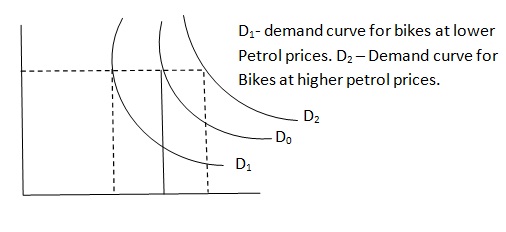As we know, goods are often interrelated; many of them are close substitutes for each other, while some of them are complementary. Any change in the prices of such substitute or complementary goods is bound to affect the demand for this particular commodity.
(i) Price-demand Relationship in case where two Goods are Substitutes. The price-demand relationship in the case of substitute goods the diagram the price of coffee is shown on the Y – axis, while the demand for tea is shown on the X-axis. With the price of coffee at OP0, the demand for tea is OM0. But as the price of coffee goes up to OP1, some people are likely to use more of tea in place of coffee. Consequently, the demand for tea goes up to OM1. But if coffee becomes cheaper, uiz. Its price falls to OP2, people may start using more of coffee in place of tea as well. Hence, the demand for tea falls to a lower level OM2. If we show the demand for tea on the same X- axis and price of tea on the Y- axis, then the demand curve D0 shows that with a given price of tea OPo, demand for tea is OM0 on the assumption that price of the substitute good coffee is given and fixed at say $ 100 per unit, quantity of tea remains unchanged but that of coffee goes up to $ 150 per unit, quantity of tea demanded will go up from M0 to M1. Conversely when price of coffee falls, demand for tea will decrease to M2 even though tea price does not change.


(ii) Price- demand Relationship when two Goods are Complementary. Some goods are complementary i.e. they can be used together. Such goods include petrol and motor vehicles, rice and pulses, etc. now, if the price of petrol becomes exorbitantly high, it may have an adverse effect on the use of care and scooters, and may ultimately reduce their demand. Thus, the rise in the price of good will reduce its demand even when its price remains the same. Similarly, a reduction in the prices of goods complementary to this particular commodity would boost its demand.
the price- demand relationship between complementary goods. Since the two goods, bikes and petrol, are complementary, then a change in the price of petrol is likely to affect the demand for bikes. The price of petrol is shown on the Y – axis whiles the X – axis measures the demand for bikes.

Since both goods, petrol and bikes, are used together in a certain proportion, a rise in the price of petrol from OP0 to OP1 would reduce the demand for bikes. Since less of petrol is being consumed, it would also mean that the demand for complementary good, bikes will also fall from OM0 to OM1. Similarly, when petrol becomes cheaper, it induces a larger consumption of petrol, which in demand for bikes.

We can show this interdependence of price and demand for complementary goods in another way. The original demand curve that shows that at a given market price of petrol OM0 quantity of bikes are demanded at price OP0 per bike. Now prices of bikes remains constant, but petrol prices fall. This will shift the demand curve for bikes upward and now a higher quantity of bikes (OM1) will be demanded. Conversely, if there is a rise in petrol price, then demand curve for bikes will shift to D2 and lesser quantity (OM2) will be demanded.
SUBMIT ASSIGNMENT NOW!